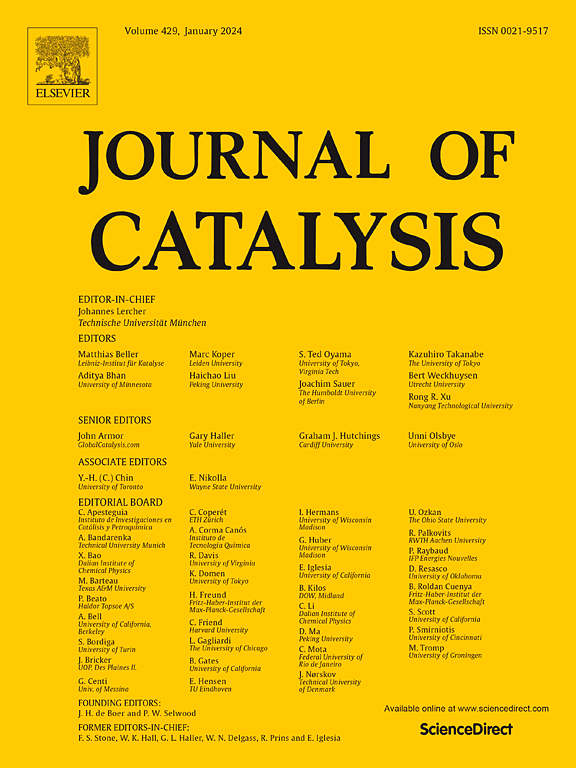近红外光下高效CO2光还原的等离子体CuSe/CuTCPP s方案异质结
IF 6.5
1区 化学
Q2 CHEMISTRY, PHYSICAL
引用次数: 0
摘要
为了最大限度地利用太阳光谱进行CO2光还原,需要具有强近红外响应的光催化剂。本文采用静电自组装策略制备了2D/2D CuSe/CuTCPP异质结。CuSe独特的局域表面等离子体共振(LSPR)效应不仅扩大了催化剂的光吸收范围,而且由于其优异的光热效应,有利于热电子的产生。此外,CuSe和CuTCPP之间S-scheme异质结的构建有效地促进了光生载流子的输运和分离。在不使用任何牺牲剂的情况下,CuSe/CuTCPP异质结可以在可见光-近红外光下选择性地将CO2还原为CO。CuSe/CuTCPP的CO生成速率最高可达198.4 μmol·g−1·h−1,在450 nm处的表观量子效率为0.21 %,是CuTCPP的2.5倍。最后,基于原位XPS和原位DRIFTS分析,初步揭示了电荷转移和光反应的机制。该研究为通过耦合s -图式异质结和非贵金属LSPR效应实现高效光催化CO2还原提供了新思路。本文章由计算机程序翻译,如有差异,请以英文原文为准。

Plasmonic CuSe/CuTCPP S-scheme heterojunction for efficient CO2 photoreduction under visible-near-infrared light
For maximal utilization of solar spectrum in CO2 photoreduction, photocatalysts with a strong near-infrared (NIR) response are highly desirable. Herein, 2D/2D CuSe/CuTCPP heterojunctions were prepared by an electrostatic self-assembly strategy. The unique localized surface plasmon resonance (LSPR) effect of CuSe not only expands the light absorption range of the catalyst, but also facilitates the generation of hot electrons due to its excellent photothermal effect. In addition, the construction of S-scheme heterojunction between CuSe and CuTCPP effectively promotes the transport and separation of photogenerated carriers. Without any sacrificial agent, the CuSe/CuTCPP heterojunctions can selectively reduce CO2 to CO under visible-NIR light. The highest CO generation rate of CuSe/CuTCPP reaches 198.4 μmol·g−1·h−1, corresponding to an apparent quantum efficiency of 0.21 % at 450 nm, 2.5 times higher than that of CuTCPP. Finally, the preliminary mechanisms of charge transfer and photoreaction are unraveled based on in-situ XPS and in-situ DRIFTS analysis. This study provides a new idea for efficient photocatalytic CO2 reduction via coupling S-scheme heterojunction and non-noble-metal LSPR effect.
求助全文
通过发布文献求助,成功后即可免费获取论文全文。
去求助
来源期刊

Journal of Catalysis
工程技术-工程:化工
CiteScore
12.30
自引率
5.50%
发文量
447
审稿时长
31 days
期刊介绍:
The Journal of Catalysis publishes scholarly articles on both heterogeneous and homogeneous catalysis, covering a wide range of chemical transformations. These include various types of catalysis, such as those mediated by photons, plasmons, and electrons. The focus of the studies is to understand the relationship between catalytic function and the underlying chemical properties of surfaces and metal complexes.
The articles in the journal offer innovative concepts and explore the synthesis and kinetics of inorganic solids and homogeneous complexes. Furthermore, they discuss spectroscopic techniques for characterizing catalysts, investigate the interaction of probes and reacting species with catalysts, and employ theoretical methods.
The research presented in the journal should have direct relevance to the field of catalytic processes, addressing either fundamental aspects or applications of catalysis.
 求助内容:
求助内容: 应助结果提醒方式:
应助结果提醒方式:


